Comparing Key Decision-Making Techniques
BABoK V3 places significant emphasis on decision making by business analysts. Making correct decisions is important as the organizations can avoid waste by choosing the right options.
However, BABoK provides 3 techniques which one can use to make decisions. There seems to be quite a bit of overlap among them as well.
They are
- Evaluation criteria (aka Selection criteria)
- Decision model
- Decision analysis
When should we use which approach?
Let’s explore.
Before we compare the 3 techniques, let’s pick the descriptions provided for the 3 techniques from BABoK.
Evaluation Criteria
Evaluation criteria define a set of measures to rank multiple options based on their value to stakeholders, thus allowing a range of scores. Value attributes can be performance, applicability, scalability, reliability etc. Evaluation criteria must be able to measure values features provide to stakeholders.
Decision modeling
Show how repeatable business decisions are made using data and knowledge.
Decision tables
A tabular representation of a set of rules. Each row/column is a rule and each column/row represent one of the conditions of that rule.
| Criteria | Graduate | Postgraduate |
| Scored > 60% | Not eligible | Eligible |
| Scored > 75% | Eligible | Eligible |
Decision trees
Each path on a decision tree leaf node is a single rule. Each level in the tree represents a specific data element; downstream branches represent different conditions that must be true to continue down that branch.
Decision trees include Decision nodes - Different strategies, Chance nodes - Define uncertain outcomes, Terminator or end nodes - Identify final outcomes.
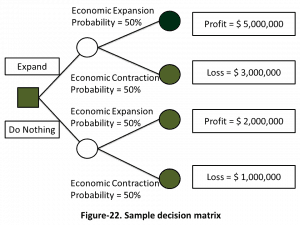
Decision Analysis
Supports decision-making in complex, difficult, or uncertain situations. Examines and models possible consequences of different decisions.
Understand:
- Values, goals, and objectives relevant to the decision problem,
- Nature of decision to be made,
- Areas of uncertainty that affect the decision,
- Consequences of each possible decision.
2 types of decision matrices:
Simple decision matrix:
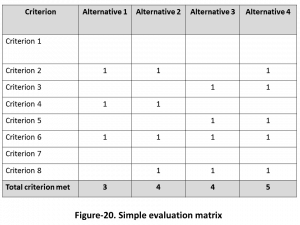
Each alternate is checked against each criterion. Tally the number of criteria matched for each of the alternates. Choose one with the maximum tally.
Weighted decision matrix:
0ptions are assessed against weighted criterions. Weights are assigned based on their importance. The higher weighting, more important criterion. The formula is the Sum of (Weight i * Rating i)
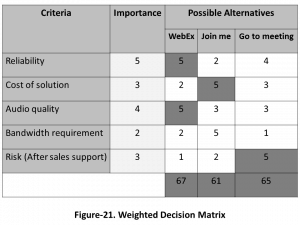
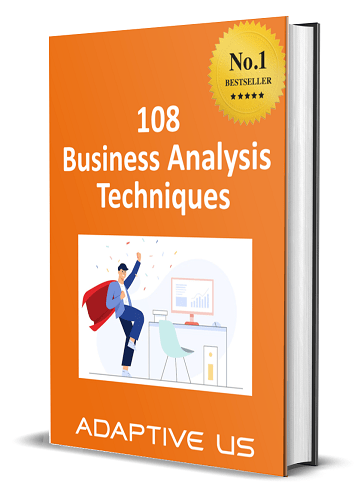
Decision trees
Decision analysis also uses Decision Trees as well.
Comparing and contrasting the 3 techniques
Now let’s observe the contradictions for Decision analysis technique. Don’t simple and complex decision matrices look exactly like Evaluation criteria?
In my humble opinion, these 2 decision matrices should have been part of Evaluation criteria.
Now decision tree appears in both decision model and decision analysis?
Will we be using decision tree in repeatable processes? Unlikely. Hence, the decision tree should be placed only in Decision analysis, not in Decision Modeling.
One can argue that a decision tree is indeed a diagram, hence should be part of the decision model. Since the decision model deals with simple and repeatable decisions, wouldn’t a flow chart not suffice for decision model?
From the examination point of view, let’s summarize the 3 techniques as below:
| Evaluation criteria | Decision model | Decision analysis | |
| Purpose | To select one option among multiple options | Provide decisions to common business situations | Provide decisions to uncommon business situations |
| Applicable situation | Simple and one time | Simple and repeatable | Complex and uncertain |
| Techniques | Decision matrices | Decision table
Flowchart |
Decision tree
|
| Usage frequency | One time | Multiple | One time |
We would love to seek the opinion of other business analysts on these 3 decision-making techniques.About Adaptive US (Think BA. Think Adaptive.)
Adaptive US provides CBAP, CCBA, ECBA, and AAC Training online and consulting needs for Individual or Corporate either online or offline. Adaptive US is an endorsed education provider of IIBA®
Learn more about this Best IIBA Certifications Training. For more updates on courses & tips follow us on Facebook | Twitter | LinkedIn | Google+ Other blogs you may like:
BABoK terms that confuse us the most
Applying BABoK to our personal lives
Demystifying BABoK V3 terms
You May Also Like
These Related Stories
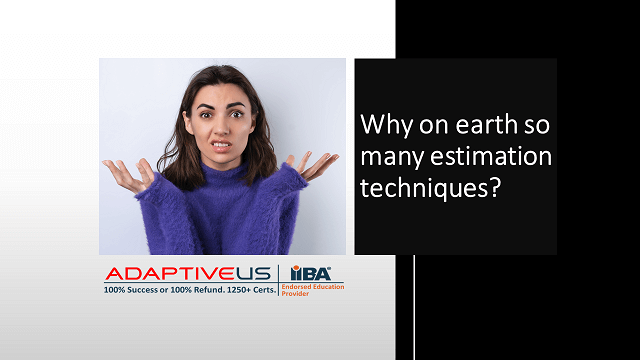
Top 10 BA Estimation Techniques | Adaptive US

How to remember 50 BABoK Techniques | Free Summary


No Comments Yet
Let us know what you think